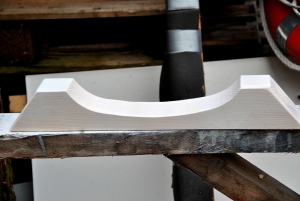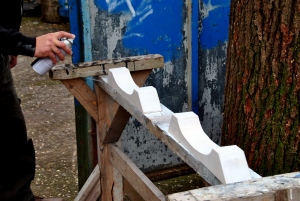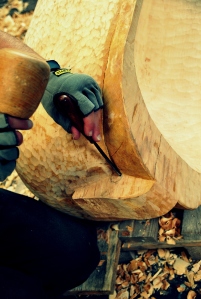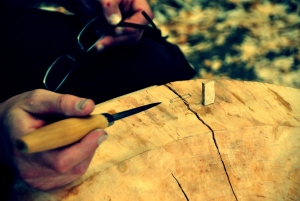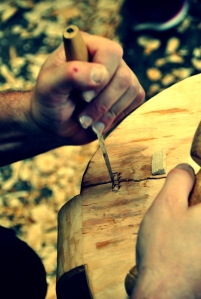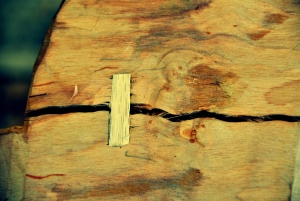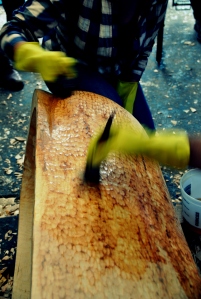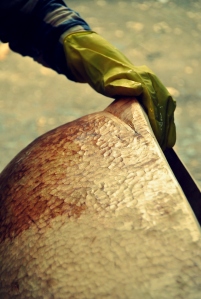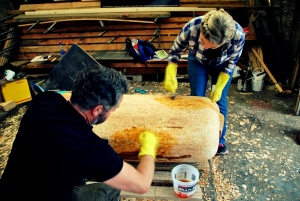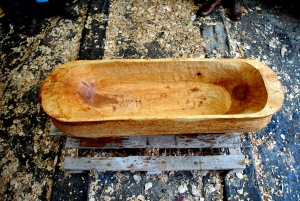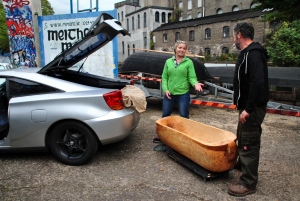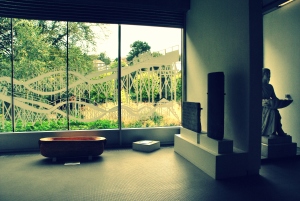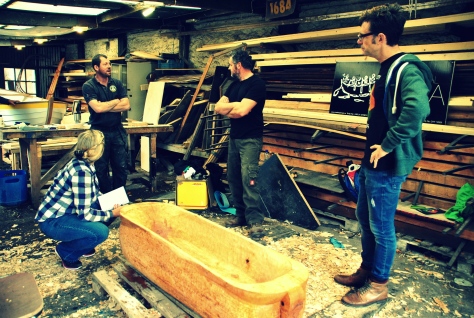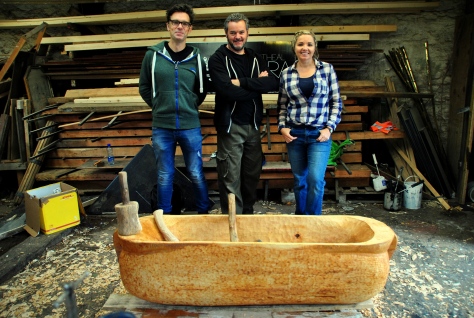Mark Griffiths
Photography by Muireann Ní Cheallacháin
We planned to deliver our vessel to Cork Public Museum early that afternoon, and there was still much to do.
Meitheal Mara is quiet as most of the boat builders are away preparing for the river race taking place later that day. The vessel sits on its bed of fresh alder chippings. Looking it over I mentally list, and prioritise, the day’s order of work.
There has been much discussion about the style of plinth needed to display our Pallasboy. The museum staff had left the design up to us as long as it was sturdy. So in the end we decided on two very simple white painted bearers. The idea is to display the vessel low to the ground, as this was most probably how it was originally intended to be. The two discreet bearers adding stability and support.
Coming, as they do, at the top of my list I start the day by making these shaped bearers. As well as suppling the timber Seamus kindly gives me the run of the workshop. After only three days of Iron Age woodworking I find myself marvelling at the efficiency of bandsaws and power sanders, like some time traveling tradesman.
With the bearers shaped, sanded and their first coat of paint drying in the sun I turn my attention to adding the remaining pattern detail to the vessel’s underside. Around ten o’clock, as I’m on the last section, Ben and Caitriona arrive laden with brushes, rags, rubber gloves and linseed oil. Alarmed by the rate the timber is drying out, causing large splits on the rim and small hairline cracks which radiate out from the pith, we have made the decision to soak the wood in oil. As far as we know there is no evidence to suggest the original vessel had been treated with any form of preservative finish. However, one theory suggests that the original had been submerged in the wet bog to swell the timber, and in doing so check the splits and cracks. With the interest our project was generating we wished to keep the replica Pallasboy on public display for as long, and in as many locations, as possible. And to this end we would need to keep it in as best shape as was we could.
Before any oil could be applied there were still two small tasks left on my mental to-do list. Firstly, the holes in the shaped handles needed to be bored through, a straight forward job using a small gouge and mallet. Next was our experiment with the wooden wedge. Caitriona had pointed out to me on our visit to the storage unit at Swords the near invisible tiny timber wedges which had, incredibly skilfully, been cut in across one large split in an attempt to stabilise the movement. We were interested in replicating this idea by fixing a wedge across our own large split.
Using a small knife, I crafted a small 10mm x10mm (1/2”) Oak wedge. With the same knife I then carved a tapered slot, slightly smaller than the wedge, across the split. Without the use of any form of adhesive I drove the wedge into the slot, relying on the force of the blow to hold it in place.
After one final check-over Caitriona and I got to work applying the linseed oil. Using large paint brushes we drenched the parched timber, paying extra attention to the dry cracked end grain. As we worked Muireann recorded the transformation of the wood from a dull straw colour to a rich honey. The grain magically displaying its wild, complex pattern, and the chip carving suddenly coming to life as the light played across the vessels surface. Leaving the oil to dry we all headed over to check things at the museum.
Later that afternoon we returned to the boat yard and carefully loaded the vessel into Caitriona’s car. I packed away my tools and swept the last wood chippings from the floor knowing that my brief connection with Meitheal Mara, and the people who worked here was at an end. They had generously provided the perfect working space for our project, putting up with us taking over a large section of the yard, accepting the constant visits from those interested in what we were doing, and always happy to lend tools, share knowledge or just make a much needed cup of tea. Seamus and all of the boat builders had warmly welcomed me into their very special and unique workspace. The time I had spent here would always stay with me.
Its five o’clock, and we are together in Cork Public Museum. We are missing Brian who is lost to his duty’s organising the events for tonight. Brian has played a such a crucial role in getting us to this point, and we all wish we could be sharing this moment with him. Muireann captures the three of us standing next to the Pallasboy we have created. It sits below a wall of window looking out on to Fitzgerald Park, and beyond to the river.
We encourage the visiting public to touch the vessel, watching as their fingers explore the shapes and patterns formed by the tools. Our Pallasboy has become an object of significance, here in the museum people react and respond to it in a way that must echo the intent of the original, over two thousand years ago. Early this morning at Meitheal Mara the vessel was ours, we had made it, watching it now being touched and discussed by others I had a feeling of detachment, and a sense of loss. This sensation will be known to all those who create and build for their living, and I’m sure it would have been known to the maker in who’s footsteps I had been walking.
We left the museum and headed out to enjoy Culture Night. Brian and his band of helpers had organised an event that spanned the city, and brought the population of Cork out into the streets to celebrate their culture, the same culture that many centuries past had crafted a vessel from an alder tree, and then cast it down into the wet earth.
On the short taxi ride to the airport the driver asked what had I done during my stay in Cork, I told him of the project, the friends and the city, “Sounds like you’ve had a good time of it” he said, “Yes, I have” I replied.

